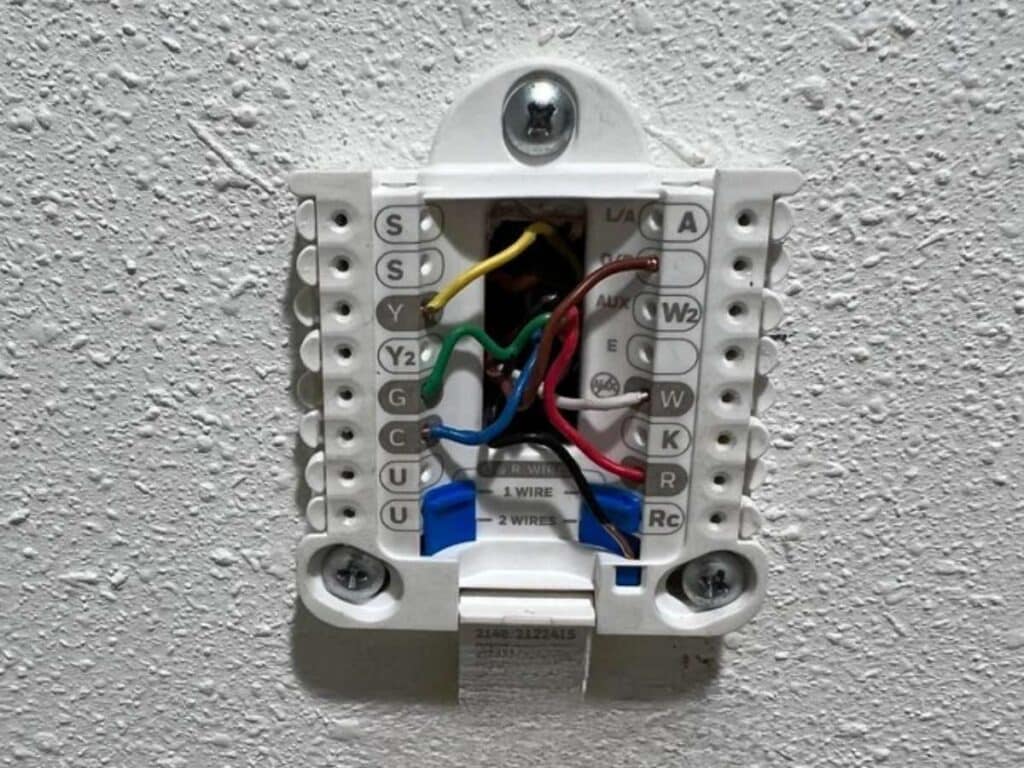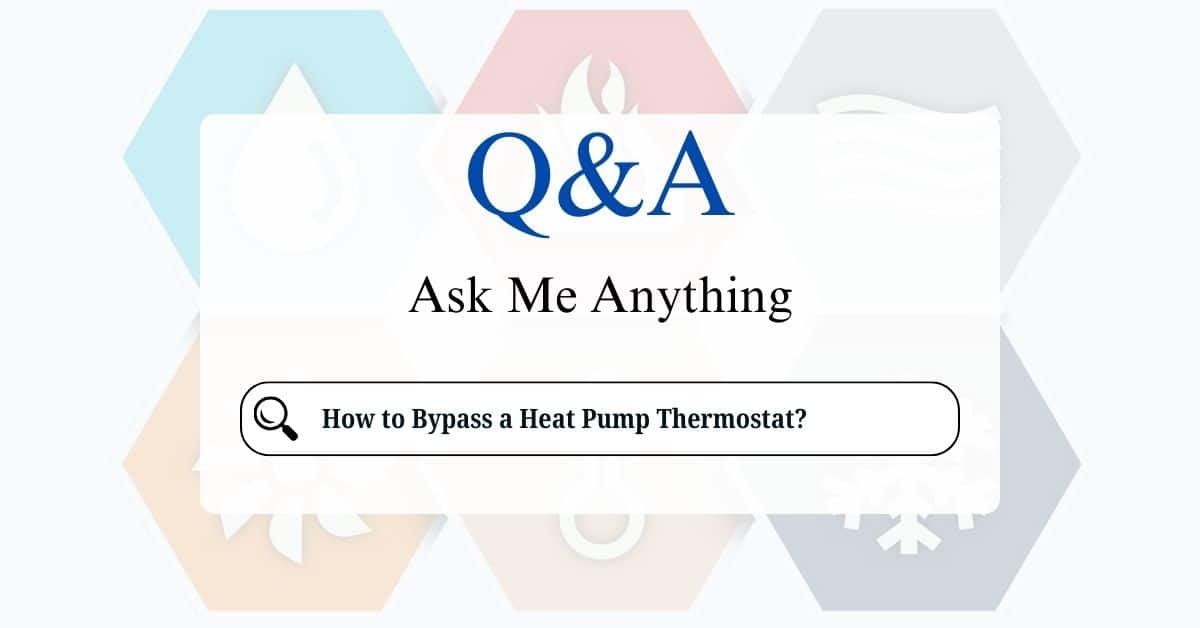Sometimes, you might encounter a situation where your heat pump thermostat isn’t working as expected, and you need heat immediately. In such cases, you might consider bypassing the thermostat to get the system running. However, it’s crucial to understand that this is a temporary solution and should only be used in emergencies.
This friendly guide will explain when and how to (carefully) bypass your heat pump thermostat, along with important safety considerations.
Why Would You Need to Bypass Your Thermostat?
There are very few legitimate reasons to bypass your heat pump thermostat. The most common scenarios are:
- Thermostat Failure: If your thermostat is completely unresponsive or displaying error codes, bypassing it might be a temporary way to get heat until you can replace the thermostat.
- Troubleshooting Purposes (Advanced): In some advanced troubleshooting scenarios, a qualified HVAC technician might temporarily bypass the thermostat to isolate a problem within the system. This is not recommended for homeowners.
How to (Carefully) Bypass a Heat Pump Thermostat?
The simplest way to bypass a heat pump thermostat is to directly connect the wires that control the heating function. This method only works if the thermostat is the source of the problem.
- Locate the Thermostat Wires: Remove the thermostat from its base plate. You’ll see several wires connected to terminals.
- Identify the Heating Wires: The wires responsible for heating are usually labeled “Y” (for the compressor/heat pump), “W” (for auxiliary heat), and “R” (for power). The color coding may vary, so consult your thermostat’s wiring diagram if you’re unsure.
- Connect the R and Y Wires (Heat Pump Only): If you only want the heat pump to run (and not the auxiliary heat), carefully connect the “R” (power) wire to the “Y” (compressor/heat pump) wire. This will directly power the heat pump’s heating function.
- Connect R, Y, and W Wires (Heat Pump and Auxiliary Heat): If you want both the heat pump and the auxiliary heat to run, carefully connect the “R” (power) wire to both the “Y” (compressor/heat pump) wire and the “W” (auxiliary heat) wire.
- Secure the Connections (If Possible): Use wire nuts or electrical tape to secure the connections if possible. This is safer than simply twisting the wires together.

Important Considerations:
- No Temperature Control: When the thermostat is bypassed, the heat pump will run continuously. You won’t be able to control the temperature.
- Monitor the System: Keep a close eye on the system while it’s bypassed. If you notice any unusual noises, smells, or other problems, turn off the power immediately.
- Restore Normal Wiring: Once you’ve resolved the thermostat issue (by replacing it or having it repaired), disconnect the bypassed wires and reconnect the thermostat wires to their proper terminals.
More Complex Bypass Methods (Not Recommended for Homeowners)
There are more complex methods for bypassing a thermostat, such as using jumper wires or directly manipulating the wiring at the heat pump’s control board.
These methods are not recommended for homeowners and should only be performed by qualified HVAC technicians.
1. Gather Tools
- Screwdriver
- Insulated wire jumper
- Multimeter (optional, for testing electrical connections)
2. Turn Off Power to the System
- Locate the circuit breaker panel and turn off the breaker that supplies power to the heat pump.
- Verify that the system is off by attempting to turn it on at the thermostat.
3. Access the Thermostat Wires
Remove the Thermostat Cover:
- Use a screwdriver to remove the cover of the thermostat.
- Expose the wiring terminals connected to the thermostat.
Identify the Wires:
- Thermostats for heat pumps typically use these standard wire labels:
- R: Power (red wire).
- Y: Compressor.
- G: Fan.
- O/B: Reversing valve (switches between heating and cooling).
- W: Auxiliary heat (if applicable).
- C: Common wire (blue wire, for continuous power).
4. Create a Jumper Connection
Connect the R Terminal to the Desired Function:
- Use a small insulated wire to connect the R terminal (power) to the appropriate terminal:
- R to Y: Activates the compressor for cooling.
- R to Y and G: Activates the compressor and the indoor fan.
- R to W: Activates auxiliary/emergency heat.
- R to O/B: Activates the reversing valve for cooling mode (in most systems).
Secure the Jumper Wire:
- Ensure the jumper wire is securely attached and not touching other terminals to avoid short circuits.
5. Turn the Power Back On
Restore power to the heat pump by turning the breaker back on.
6. Test the System
Observe the heat pump’s operation:
- If the system runs as expected when bypassing the thermostat, the thermostat is likely faulty.
- If the system doesn’t respond, there may be an issue with the heat pump itself, such as a wiring problem or component failure.
If you’re not comfortable working with electrical wiring, it’s best to call a qualified HVAC technician. Improperly bypassing the thermostat can damage your system or create a safety hazard.
Bypassing the thermostat is only a short-term solution. You should address the underlying thermostat issue as soon as possible.
When You Should Not Bypass Your Thermostat?
- Minor Temperature Discrepancies: If your home is just a few degrees colder than you’d like, adjusting the thermostat settings or checking for other issues (like dirty air filters) is the appropriate course of action, not bypassing the thermostat.
- Regular Operation: Bypassing the thermostat for regular heating is not advisable. It prevents the system from cycling on and off properly, leading to inefficiency and potential damage.
Bypassing a heat pump thermostat should only be considered a temporary solution in emergency situations. It’s crucial to prioritize safety and address the underlying thermostat issue as soon as possible. If you’re unsure about any part of the process, it’s always best to contact a qualified HVAC technician.






